Not only do herbs add so much depth and flavor to dishes, but they also contain more antioxidants than just about every fruit and vegetable out there. From thyme to tarragon, these herbs are not only easy to grow, but they’ll make your food taste better.
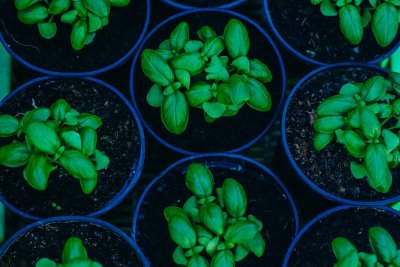
#1. Basil
Basil is a common culinary herb, and is a part of the mint family. An important medicinal plant in various parts of the world, basil brings with it so many different health benefits:
- Anti-inflammatory
- Analgesic, meaning it reduces pain
- Antioxidants
- Protects the liver and blood vessels
- Boosts the immune system
- Reduces stress
When it comes to cooking with basil, pesto is one of the most popular dishes, as this enables you to make use of so much of the herb, and doesn’t require many other ingredients.
Basil also works well when paired with seafood, such as in garlic basil shrimp, lemon basil salmon, or halibut with capers, cherry tomatoes and basil.
Don’t neglect basil when it comes to desserts either, as this herb complements strawberries, as well as lemons and limes, beautifully.
In addition to eating it, you can use it topically, meaning apply it directly to the skin. The essential oil that can be extracted from basil is packed with antioxidants, and contain compounds that are small enough to easily penetrate the skin.
Did you know that there are actually 35 different varieties of basil?
Here are a few worth growing:
- Sweet Basil – this is the type that you would usually find in a grocery store
- Genovese Basil – classic Italian basil with large, dark green leaves
- Purple Basil – not as sweet but highly aromatic, and with a vibrant purple color
- Lettuce Basil – its large, wrinkled leaves make it perfect for salads
- Spicy Globe Basil – a dwarf variety with a strong spicy flavor
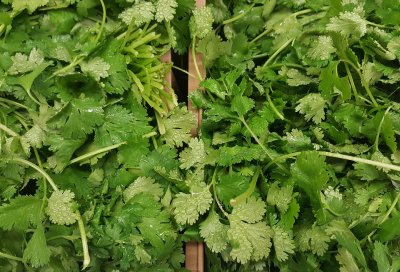
#2. Coriander/Cilantro
Also known as coriander or Chinese parsley, cilantro is so versatile to grow, as everything from its leaves to its stems to its seeds can be used in the kitchen.
Just like every other herb out there, cilantro has some great health benefits:
- Lowers skin inflammation
- Regulates blood pressure
- Has anti-histamine properties to reduce allergy symptoms
- A rich source of calcium
- Aids in digestion
- Prevents urinary tract infections
When it comes to using the leaves and stems, most people tend to just use coriander as a garnish, but there is no reason why you cannot let this herb take center stage. Cilantro makes a great pesto, and can also be turned into a spicy sauce to drizzle over meat or fish, or cooked up with carrots for a fresh and tangy soup.
Of course, if you let it flower and produce seed, you’ll have a whole new ingredient available to you. The seeds can be used in so many ways, with many Asian, Mediterranean and Middle Eastern recipes calling for them.
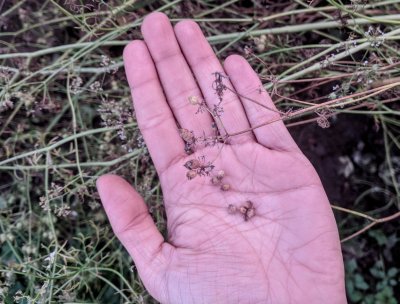
photo: cilantro seeds
If your plant produced too many seeds, try crushing some of them into a powder, as this makes a great spice to add to curries, stews and meat rubs.
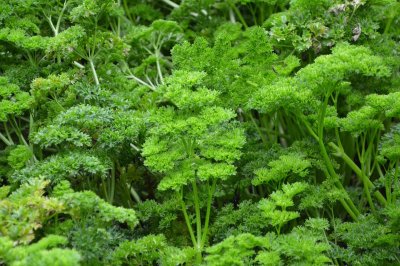
#3. Parsley
Parsley is a Mediterranean herb that has been used around the world for over 2000 years. This is a herb that is packed with vitamins, with just two tablespoons of parsley providing 12% of your vitamin A intake for the day, 16% of vitamin C, and an impressive 150% of your vitamin K intake.
Here are just a few of the other things that parsley can do:
- Supports the kidneys and prevents kidney stones
- An anti-inflammatory that can treat joint pain
- Great for anemia as it is high in iron
- Could potentially prevent and treat diabetes
There are a few different types of parsley, but you will most likely come across the flat leaf and curly parsley varieties. Both of these are fantastic for using in the kitchen. If you are looking for a perennial parsley plant, you could give Japanese Parsley a try, but this has more of a bitter flavor, and its stems are usually eaten like celery.
Thanks to its light flavor, parsley can be used in just about every savory dish out there. A parsley butter is always a delicious addition to meats, seafood and vegetables, while deep-frying it briefly gives it an exciting new texture.
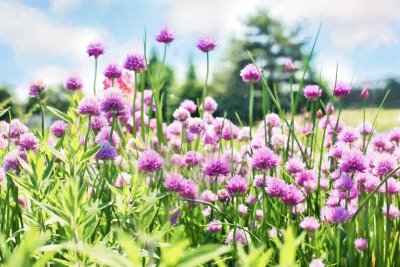
#4. Chives
A low-maintenance herb from the onion family, chives tend to be one of the first herbs to begin growing in the spring, as well as one of the last to die down in the fall. Chives are a perennial, and are so hardy, making them well worth having in your garden.
In terms of their health benefits, here is what you can expect to experience:
- Contain choline, which is a nutrient that helps with sleep, leaning, memory and muscle movement
- Contains vitamin K to contribute to bone health
While chives taste great with meat and seafood, eggs are the protein that really complement them. Whether you are scrambling, frying, or making a quiche, try throwing in a couple of handfuls of chopped chives for your dish to really shine.
Chive flowers can also be used in the kitchen, either as a pretty garnish on dishes, or they can be steeped to create a purple-colored chive blossom vinegar.
While chives can be frozen or dehydrated, this severely affects their flavor and texture, meaning that this is one herb that often does not get preserved. However, since it is a perennial, it will not be long before it makes an appearance yet again.
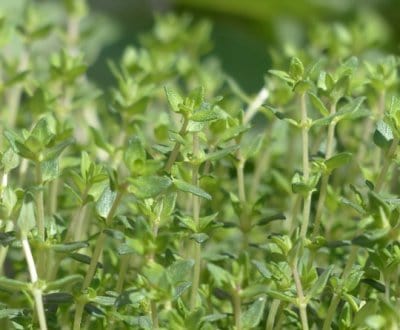
#5. Thyme
Thyme is a perennial evergreen herb from the mint family, and is wonderfully aromatic. This herb is not only used in the kitchen, but also medicinally, while some varieties serve as just an ornamental plant.
Take a look at what this humble herb can do for your body:
- Lowers blood pressure
- Alleviates coughing
- Boosts the immune system
- Deters pests, as well as bacteria
- Contains carvacrol, which enhances the mood
When cooking with thyme, you can either strip the leaves off of the stem, or just use whole sprigs. This is another herb that works really well with eggs, but also brightens up meat and seafood, especially lamb.
Unlike many other herbs, thyme holds up quite well when refrigerated, and will happily sit in your fridge for up to two weeks. However, if you would like to dry it to preserve it, this is something well worth trying, as dried thyme retains quite a bit of flavor and can be stored for up to a year.
Since thyme is a plant that hybridizes so easily, there are over 400 known species of thyme out there. Here are a few to try growing:
- Lemon thyme – the most popular variety for cooking
- Creeping thyme – a mat-forming variety, making it great for ground cover
- Oregano-scented thyme – a very cold-tolerant species
- Broadleaf English thyme – has a strong aroma and a rich flavor
#6. Rosemary
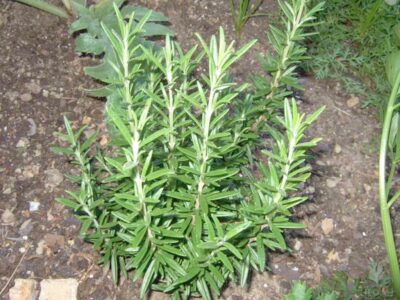
Woody, evergreen and perennial, rosemary is another popular culinary herb that comes from the Mediterranean, and since it is able to survive relatively pest-free, is one that everybody should have in their garden. This is such a fragrant herb to grow, and, in addition to being gorgeous to look at, this herb provides so many health benefits:
- A cognitive stimulant that can boost memory and increase intelligence
- Improves mood and relieves stress
- Boosts the immune system
- Alleviates bacterial infections
- Soothes the stomach and regulates the bowel
- Stimulates blood flow
Rosemary is frequently used both fresh and dried. In its fresh form, it can either be used as whole sprigs in everything from roast vegetables to Italian breads. You can also use it in stuffing for meat and fish, but, if you are going to chop it, make sure that you do it finely.
Since rosemary has such an aromatic flavor, it also lends itself well to many deserts, from fruit salads to sorbets.
If you’re using dried rosemary, try to crush it between your fingers before adding it to food, as the leaves can sometimes be quite sharp.
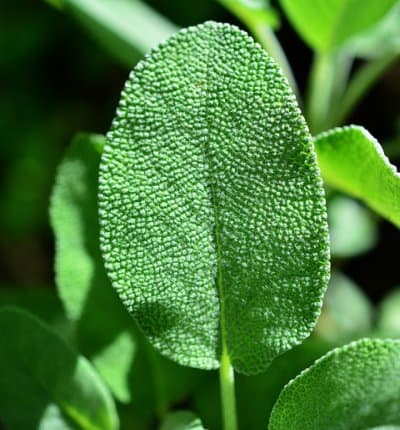
#7. Sage
The earliest documented use of sage was with the Ancient Egyptians, who used it as a fertility drug. Sage has one of the longest histories out of all culinary and medicinal herbs, and this is because of all of the incredible health-boosting properties it contains:
- Helps with memory loss
- Improves cognitive function in patients with Alzheimer’s
- Kills bacteria and prevents fungal infections
- An antioxidant that can also soothe indigestion
- Relieves hot flashes during menopause since it is high in astringent tannins
- Can be used topically as a skin toner or hair rinse
Sage has quite a strong flavor, so you do not need to use much of when cooking. Sage pairs beautifully with dairy, and works great with dishes containing cheese.
In Italy, sage is commonly chopped up quite finely, and then mixed with melted butter before being stirred into pasta or gnocchi. This concept could also be applied to meat and seafood, which sage would really enhance.
In terms of the different sage varieties out there, many are best as ornamental plants, so you do need to be careful when choosing a variety for culinary purposes. Garden sage and purple sage are the most commonly used in cooking, while berggarten sage is a hybrid variety that is exceptionally fragrant.
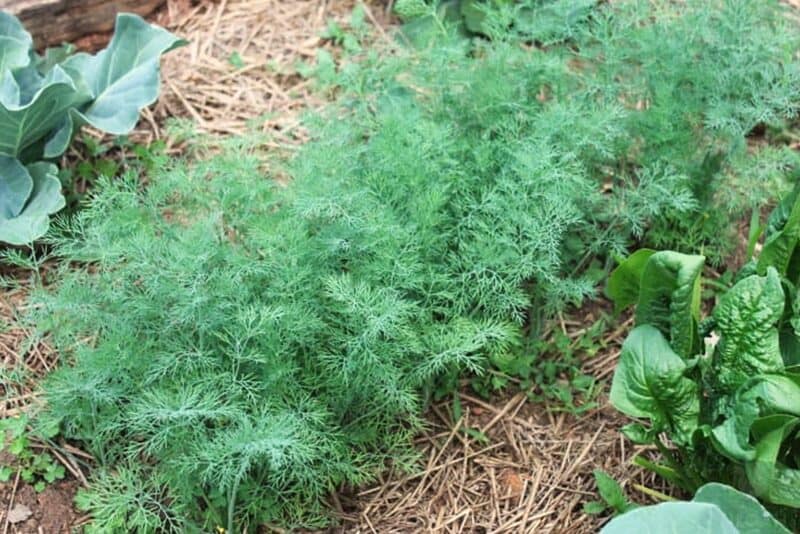
#8. Dill
A member of the parsley family, dill features delicate, feathery leaves that grow in clusters, and have a soft, pleasant texture. Dill seeds are also used in the kitchen, and both the leaves and the seeds are incredibly good for you:
- Contains antioxidant compounds
- Rich in many vital vitamins, with 100g of dill springs providing 257% of your daily recommended intake of vitamin A, and 140% of vitamin C
- A good source of minerals including copper, magnesium, iron and potassium
Dill has a unique, anise-like flavor, but, since it is quite a delicate herb, it is usually best saved until the end of the cooking process. Fish and eggs are the two proteins that dill works best with, although just about any poultry dish would benefit from a sprinkling of dill.
The seeds should also not be forgotten about. Dill seeds are key when it comes to dill pickles, as well as making a dill vinegar. Whether you use them whole or crush them up, dill seeds can be incorporated into everything from breads to soups.
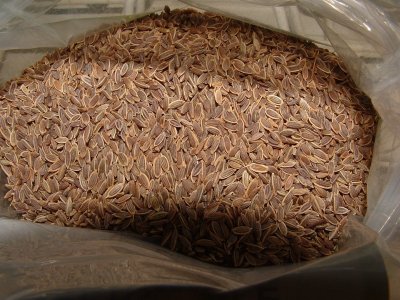
photo above: dill seeds
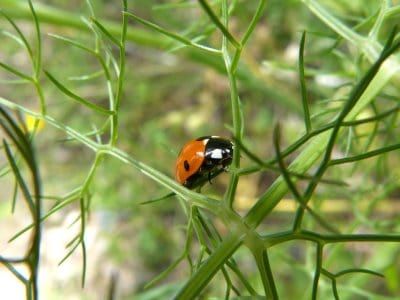
photo above: fennel
#9. Fennel
There are two types of fennel out there, but they look and taste differently. The first type of fennel is treated as a bulb-type vegetable, while the second is a perennial herb. The herb is a hardy plant, with feathery leaves and yellow flowers, and has important health properties:
- Relaxes the lining of the digestive system, and can help to rebuild it after chemotherapy
- Can treat IBS, acid stomach, gas, motion sickness and more
- Relieves respiratory conditions, and is a common ingredient in cough remedies
- Contains iron, making it great for treating anemia
- Increases milk production in nursing mothers
- Relieves anxiety and depression
- Eases muscular pain
- Insect repellent
As you can see, fennel is worth growing, especially since it can be used in the kitchen in so many ways. The most obvious recipe for any green would be a pesto, but, if you want to get more creative, try using the fronds to create a bed on which you cook some fish, whether this may be grilled, roasted or steamed.
Fennel seeds can be gently bruised and then steeped in water to create a tea, to can experience its health benefits quickly. Fennel is commonly used to make tea, and is a key ingredient in chai. When you’re using the fennel seeds whole, make sure that you crack or bruise them slightly, as this helps to release their fragrant oils.
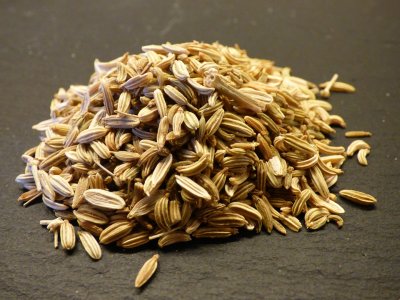
photo: fennel seeds
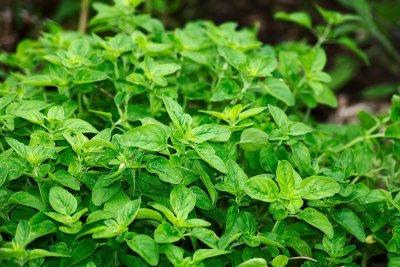
#10. Oregano
An ancient culinary and medicinal herb, oregano is a hardy perennial with a robust scent and flavor. Of the herbs out there, oregano ranks the highest in terms of antioxidant content, and offers significant health benefits:
- Protects against certain cancers, heart disease and stroke
- Can help to manage diabetes when used alongside other herbs
- Antibacterial properties
- Aids in digestion thanks to its fiber content
- Detoxifies the body
- Boosts energy levels
When many think of oregano, pizza is the first dish that comes to mind, and this is because oregano is one of the main herbs to flavor pizza sauces, and is also sprinkled on top in many countries.
Oregano goes so well with a variety of foods, from meat and seafood to vegetables and grains, making it suitable for your garden no matter what you tend to eat. Try mixing in some chopped oregano the next time you are making burgers, or minced into a marinade to top a roast chicken, with a few sprigs placed inside for extra flavor.
Oregano has quite a high oil content, meaning that it is a herb that dries quite well. However, it can lose its pungency after a few months, so will need to be replaced regularly.
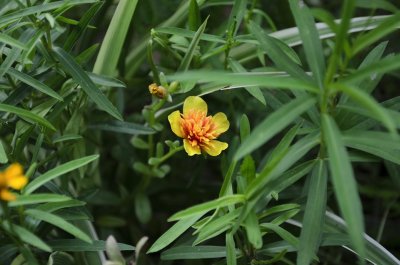
#11. Tarragon
Tarragon is in the sunflower family, and is a perennial herb that features long green leaves with yellow/white flowers. Compared to the other herbs on this list, tarragon is not as frequently used, but it adds such a distinct flavor in the recipes that do call for it.
Here are a few of the benefits that you will experience by eating more tarragon:
- Contains chemicals that stimulate the appetite
- Toothache remedy thanks to its eugenol content, which is a pain relieving compound
- Antioxidant properties help to slow down the aging process
- Aids in digestion
- Works as a mild sedative to help with stress and anxiety
- Supports heart health
- Rich in potassium and vitamin A, making it great for the eyes
- Helps to build muscle
Tarragon is a key herb in many classic French dishes, such as a traditional bearnaise sauce and coq au vin. Keep in mind that heat diminishes their flavor, so only add them into your dishes in the last 15 minutes of cooking.
In addition to cooking with the leaves, you can also use them to flavor different condiments. Try creating a tarragon-infused mustard, and using this to pep up burgers and hot dogs, or a herb vinaigrette featuring tarragon, parsley and thyme.
The two varieties most commonly grown for the kitchen are French tarragon and Russian tarragon. If you have to choose between the two, opt for the French, as the Russian variety tastes slightly bitter, and does not have as good an aroma.
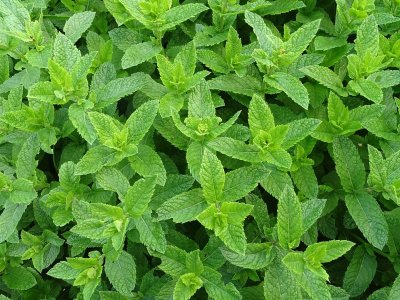
#12. Mint
Mint is an aromatic perennial that spreads extremely quickly, meaning that you need to grow it in a container if you do not want it to take over your garden. While this herb can be difficult to contain, it makes up for it with the goodness that it brings to the body:
- A digestive aid
- Treats headaches and nausea
- Protects against respiratory disorders
- Relieves congestion and is a relaxant, making it great for treating asthma
- A natural stimulant that can reduce fatigue and depression
- Aids in weight loss
- Prevents memory loss
- An anti-septic and anti-pruritic, making it great for the skin
Mint is most commonly used in beverages, from hot mint teas to refreshing fruit and mint-infused waters. However, it’s an ingredient that can also be incorporated into savory dishes. Mint adds a zing to potatoes, as well as to peas, or, if you would like something more exotic, try putting together a Tabbouleh, which is a bright and refreshing Middle Eastern salad that makes use of fresh parsley too.
There are hundreds of varieties of mint, so try incorporating a few different ones into your garden:
- Sweet Mint – a common culinary variety
- Peppermint – has a purple hue to it, making it great for the kitchen as well as an ornamental plant
- Mojito Mint – if you like your cocktails, this mint has citrus overtones that make it perfect for mojitos
- Chocolate Mint – many liken the taste of this to after-dinner mint chocolates
- Spearmint – resembles peppermint, but with lavender flower spikes
There are many other culinary herbs you could grow, from borage to saffron, but these do not tend to be as commonly used in the kitchen. If you grow any culinary herbs that you simply could not do without, let us know in the comments section below!
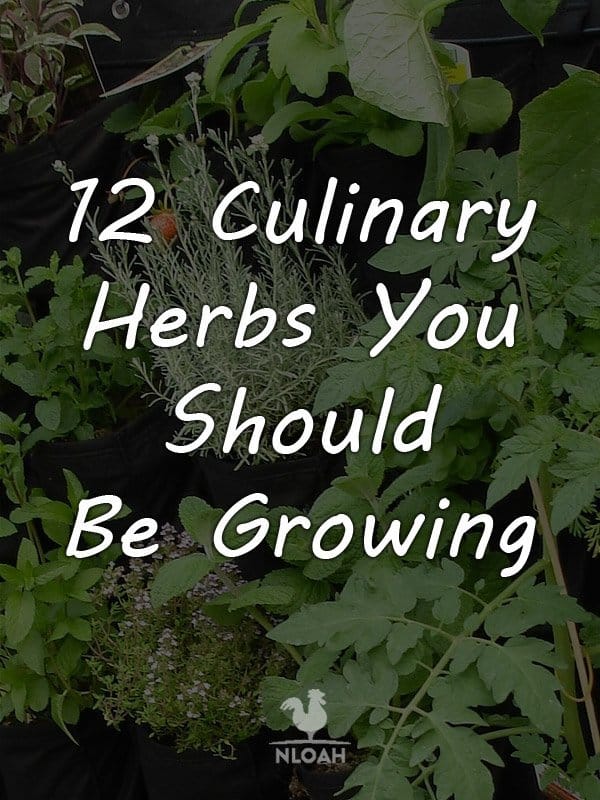

Alina was a born and bred city girl, until she moved to the Scottish countryside in 2013 to live the self-sufficient life. Thrown in at the deep end, she spent all her time learning as much about homesteading as she could, putting theory into practice each and every day. T
oday, Alina grows large amounts of food in her garden, greenhouse and polytunnel, and also has a number of different animals that call her little farm “home”.

Really great inspiration for my garden planning. Thanks!
EXCELLENT! THANK YOU!
I grow almost all but didn’t know their great values, great info,thank you much!